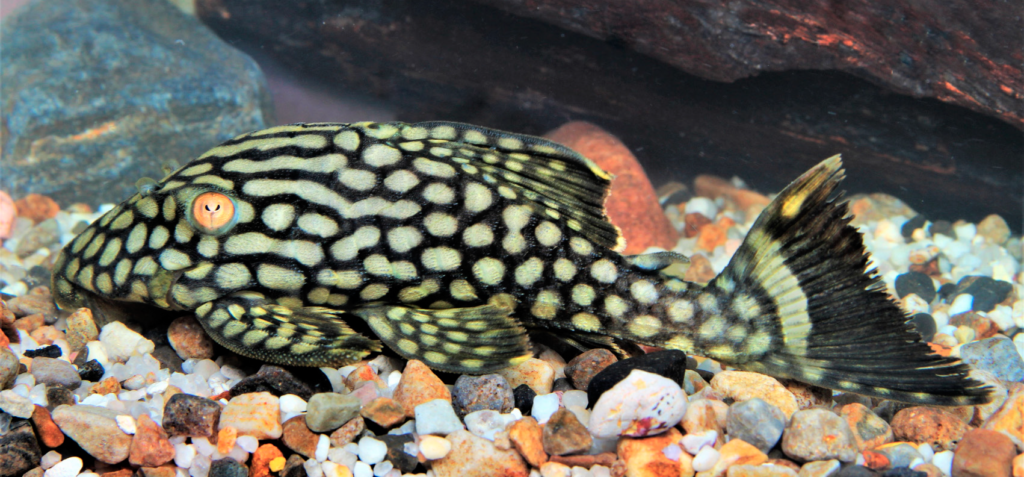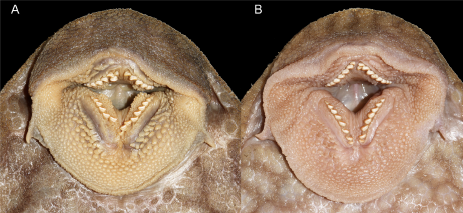
Panaque nigrolineatus laurafabianae from a tributary to the Guaviare River, Colombia. Image from Ortega-Lara and Lujan, 2020.
The wood-eating spotted loricariid catfish referred to as the watermelon pleco, the spotted royal pleco, or simply L330. is popular in the ornamental fish trade. A recently published article by Armando Ortega-Lara and Nathan Lujan in the journal Zootaxa recently elevated the status of the fish to a recognized subspecies, Panaque nigrolineatus laurafabianae.
Panaque nigrolineatus laurafabianae is generally phenotypically distinct from P. nigrolineatus based on color pattern and presence of elongated papillae located near the premaxillary and dentary tooth row. Most adult P. nigrolineatus laurafabianae have a dark base with yellow-greenish spotting on the head, body, and abdomen. While the abdomen is nearly always spotted, the dorsal pattern can have a varying degree of striping. Distribution ranges also differ whereby P. nigrolineatus laurafabianae occurs as a distinct population from the Guaviare River basin in southern Colombia. Panaque nigrolineatus was originally described from the Apure River basin in Venezuela. The authors interpret the phenotypic distinction and separate distributions as evidence that supports taxonomic recognition of P. nigrolineatus laurafabianae as a distinct evolutionary lineage.

Oral disks of (A) paratype of Panaque nigrolineatus laurafabianae, 268 mm SL, showing well-developed patches of papillae immediately interior to each premaxillary and dentary tooth row and (B) P. nigrolineatus nigrolineatus, 267 mm SL, with much smaller, more reduced patches. Fig. 3 in Ortega-Lara & Lujan 2020.
The elevation to full species status, however, can not be made at this time. Genetic sequencing showed a variation of less than 0.5%, whereas by convention a 3-4% divergence is an accepted minimal level of variation to separate species. None of the sequenced gene regions support monophyly of P. nigrolineatus laurafabianae or of individuals from the Guaviare River basin. This study had a low sample size and near future analyzes are likely limited by political turmoil in the area.
The authors were compelled to elevate the status of L330 to a distinct subspecies in order to contribute to conservation efforts and legal protection and to provide a basis for the legal tracking of harvest and export of the fish. Panaque are among the most valuable fishes to Colombia’s ornamental fish trade.
The subspecies epithet laurafavianae honors the daughter of author Armando Ortega-Lara.
Article Abstract:
The suckermouth armored catfish genus Panaque contains seven valid species, including the Royal Pleco, Panaque nigrolineatus, which has long been popular as an ornamental aquarium fish and was originally described from the Apure River basin in Venezuela. We examine a phenotypically distinct population of P. nigrolineatus from the Guaviare River in southern Colombia at the southwesternmost corner of the Orinoco River basin. In contrast to typically boldly striped populations from closer to the type locality of P. nigrolineatus, the Guaviare River basin population is usually boldly spotted, earning them the common name Watermelon Pleco in the aquarium fish trade. Because of the commercial popularity of this distinctive color morph, it is heavily exploited for export to the global ornamental fish trade. We find that the Guaviare River P. nigrolineatus laurafabianae is not only distinct geographically and in color pattern, but is also morphometrically diagnosable from P. nigrolineatus individuals from outside the Guaviare River basin. However, relatively subtle phenotypic differences, invariance in nuclear DNA markers, < 0.5% divergence in mitochondrial DNA markers 16S, cytb, and ND2, and the non-monophyly of Guaviare River populations prevent us from robustly inferring species-level distinctiveness of the Watermelon Pleco. We therefore propose to recognize this population as a distinct subspecies.
Reference:
Ortega-Lara, A. and N.K. Lujan. 2020. Panaque nigrolineatus laurafabianae, a new, commercially exploited subspecies of ornamental wood-eating pleco (Loricariidae: Hypostominae) from the Guaviare River basin in Colombia. Zootaxa 4732(3): 393-408.





